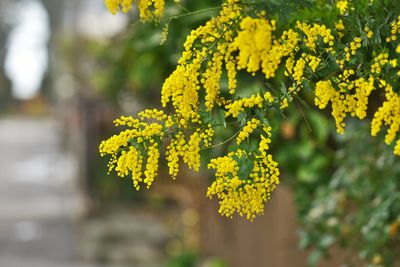What is a Bailey Acacia?
The acacia tree is native to Australia where it is called a wattle. According to Bailey acacia information, the tree is called the Cootamundra wattle, whose town by the name in South Wales claims it as a native species. Would you like to know how to grow Bailey acacia? It is quite a fascinating plant, good for soil health, as a shade tree, wildlife habitat and food, and for its wood. It also has medicinal properties and can produce a useful dye. What is a Bailey acacia? For starters, it is a 15 to 30 foot (4.5-9 m.) tall tree. You may have seen it as a sidewalk specimen or in parks to provide shade. Bailey’s acacia is a fast-growing tree which makes it excellent for reclaiming spaces after disturbances or wildfire. It has an evergreen, rounded canopy and sports bluish grey, feathery compound leaves. The foliage is comprised of 16 to 20 airy pairs of leaflets. The fragrant yellow flowers are quite pretty and pea-like in appearance. Fruits are 2 to 4 inches (5-10 cm.) long, flat, and brown. This is a very drought tolerant plant once established but has minimal wind resistance.
How to Grow Bailey Acacia
Bailey acacia is hardy to USDA zones 8-10. It has no frost tolerance and must be protected from cold snaps. Wild plants prefer light, well-draining, fertile soil. Most commonly, they are propagated from cuttings or nursery stock, but you can try growing a Bailey acacia from seed, however, it will take years to bloom and fruit. Purchase or make well-draining potting soil (3 parts sand, 1 part compost) and fill a seed flat. Moisten the medium evenly. Scarify seed prior to planting or soak overnight in water to soften. Plant seeds ¼ inch (6 mm.) under soil. Cover the container with a clear lid or plastic wrap and place on bottom heat.
Bailey Acacia Care
Keep the flat moderately moist and remove the plastic covering once per day to allow excess moisture to escape and prevent damping off of seedlings. Once the seedlings have two sets of true leaves, they should be moved into individual pots that are twice as large as the root zone. Place these in a greenhouse or cold frame in early spring. In most zones, the plants can be grown outdoors in summer weather but must come inside if any frost threatens. During the winter, except in very warm regions, bring plants indoors after thoroughly checking pots for insects. As seedlings grow, they need moderate moisture, weed removal, and light pruning to produce a vase-like open canopy. When plants are two to three years old, install them in a sunny location of the landscape in a prepared, well-draining bed.
